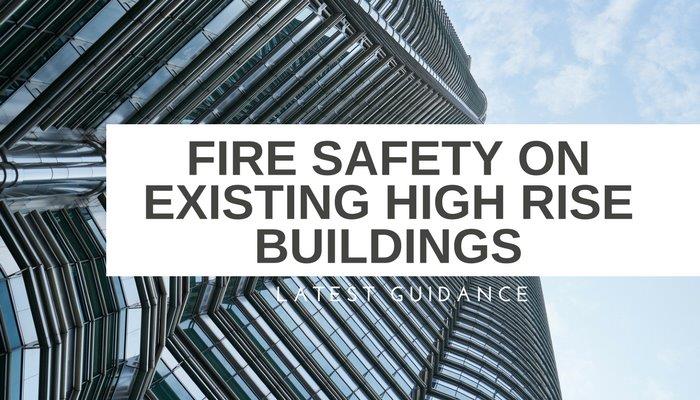
28th July 2017
RICS guidance on existing high rise buildings fire safety
SUMMARY
Following the recent tests carried out by the Building Research Establishment (BRE) on cladding materials where a failure to satisfy the guidance in the Approved Document has resulted, this guidance is to assist those RICS professionals who are faced with considering the options that are available.
This note is mainly aimed at those high rise buildings [over 18m] that are used as dwellings and a sleeping risk such as flats and dwelling type accommodation.
It does not give advice on the technical requirements in the Building Regulations as these are matters covered by Approved Documents. This note also flags common issues for building control bodies to consider when reviewing building regulation applications for cladding work. See Appendix for more technical details.
RICS recommends a holistic approach be taken to the whole building and not just the cladding in isolation. The professional that is appointed should carry out a thorough fire risk assessment of the whole fire related standards of the building including compartmentation, fire prevention/suppression, fire escapes/means of escape, means of detection and warning, as well as the cladding and its construction. The building management process, testing regime, and the evacuation policy should also be included.
The risk assessment should be a holistic assessment of the building and include an assessment of the fire spread and the likelihood of any external spread re-entering the building thereby creating a “leapfrog effect”, particularly with full height or near full height glazing.
It should be remembered that any assessor must be suitably experienced and qualified, and anyone advising in these matters must not stray outside their own area of expertise.
With regards to the decision regarding removal and replacement of any cladding, that will need to be decided based upon the results of the risk assessment, the on-site survey and possibly testing of the cladding. However any such decision to remove and replace must be carried out in consultation with the Local Authority planning office to ensure that there is no breach of the planning laws, and Building Control.
The construction that is behind the cladding will need to be assessed also, in particular the fire stopping and cavity barriers. A sample of the cladding should be removed in order to identify whether the fire stopping has been adequately constructed.
If the sample shows that there is a deficiency then more should be removed to assess the extent of the deficiency.
If the cladding on the building fails the BS 8414 test then the owner should seek professional advice as to what to do next.
Replacing individual or sample panels
In assessing the safety of the cladding system it may be necessary to remove isolated panels either to reveal the construction build up or for testing purposes. In doing so, care should be taken not to create conditions which may worsen the integrity of the cladding system. This could include exposing insulation or other materials to rain which can affect structural integrity and water tightness, or leaving material exposed which could reduce fire performance and be exposed to wind damage.
Where sample panels are removed, they should be replaced immediately with a suitable material which ensures continued compliance with all the applicable Parts of Schedule 1 to the Building Regulations including Approved Document B guidance.Responsible building owners must be advised of the risks of just removing sample panels and leaving them off for any period of time.
Structural safety
Replacement cladding may be heavier than the existing system and cladding panels, or insulation materials may have a lower resistance to fixings pulling through than the original panels.For example, replacement insulation may be heavier, particularly if it can absorb water (e.g. from rain during installation or rain penetration through the outer cladding).In addition, removal of the original panels may damage fixings, the fixing system or the building substrate.
If fixings or a fixing system is to be reused, the original design and suitability for the new application should be checked.This should also include an assessment of resistance to wind loads. It should not be assumed that the original specification of fixings was adequate as there is always a risk that the original system was not designed or installed correctly. Fixings should take account of the condition of the building substrate and performance in a fire.
Guidance on wall cladding is given in Section 3 of Approved Document A Structure. This references other industry guidance which building owners and building control bodies may find useful.
Building control process
Building control Bodies are reminded that depending on the nature and extent of works to be undertaken Fire and Rescue Services should be appropriately consulted.
Planning requirements
The removal, replacement or alteration of cladding may require planning permission. The local planning authority will be able to advise on the need for planning permission associated with any work and should be contacted at the earliest opportunity.
Conclusion
It is important to remember that when carrying out this work, life safety of the occupants and people around the building in question are paramount. Therefore any work that is to be carried out should be reflective of this.
RICS will be bringing forward updated guidance for members as more information becomes available from the panel testing and other sources.
Royal Institution of Chartered Surveyors
28 July 2017
APPENDIX
Detailed considerations
Fire safety
The requirements of Part B will apply in respect of recladding and guidance in paragraphs 12.5 to 12.9 of approved Document B applies. In particular;
External surfaces should meet the performance set out in Diagram 40.
Each element of the cladding system including any insulation product, filler material etc. should be of limited combustibility (as defined in table A7 – eg Class A2 to BS EN 13501-1).
Cavity barriers should be provided to close the edges of cavities, around openings, and in line with every compartment floor and wall.
Alternatively:
Cladding systems (including any necessary compartmentation and cavity barriers) shown to meet the performance criteriain BR 135 using full scale test data from BS 8414 -1 or -2 as appropriate will be acceptable. Where directly applicable BS8414 test data is not available and a proposal for cladding or re-cladding a building includes, as an alternative to compliance with 12.6-12.9 of AD B, an assessment of performance for a system this should be checked rigorously. Guidance in this respect is available in “Guide to Undertaking Assessments In Lieu Of Fire Test” published by the passive fire protection federation: http://pfpf.org/pdf/publications/guide_to_uailoft.pdf
Further information is available in BRE report BR135 and in Building control Alliance (BCA) Guidance Note 18.
Moisture
The building structure, insulation and cladding should be designed and installed to minimize risks from moisture. This includes ensuring that alterations to the cladding system protect the structure and substructure from rain penetration, and particular attention should be paid to copings, flashings and drainage details to ensure that insulation material is not at risk of becoming wet and that structural materials are not at risk of rot or corrosion.
Consideration also needs to be given to the risk of interstitial condensation (condensation within the wall/cladding structure) which can result from a change in fabric performance where alternative materials (particularly insulation) are removed or substituted.Guidance is given in Approved Document C, BRE Report 262 Thermal insulation: avoiding risks, and BS 5250 Code of practice for the control of condensation in buildings.
Cladding and insulation can make a building more airtight and so reduce the amount of ventilation inside the building.This can potentially lead to condensation, mould growth and ill health.Additional ventilation may be needed and guidance on this is given in Approved Document F.
Conservation of heat and power
Where an external wall, roof or (ground) floor is being renovated, Regulation 23 of the Building Regulations 2010 requires it to meet minimum energy efficiency standards where that is technically, functionally and economically feasible. ADL1B provides guidance and examples on what may be considered technically, functionally and economically feasible.Consideration needs to be given to ascertain whether the building already meets the threshold values contained in Approved Document B1.
If building owners consider that they need to re-clad their building, for example following the results of the screening test, this is very likely to be building work as defined in regulations 3 and 23 of the Building Regulations 2010 and therefore subject to Building Regulations’ requirements, in particular those relating to: structure (Schedule 1, Part A); fire safety (Part B); site preparation and resistance to contaminants and moisture (Part C); and conservation of fuel and power (Part L).
Materials and workmanship must also comply with Regulation 7.
The Department has provided advice for building owners on building safety matters which can be found at the links below:
https://www.gov.uk/government/publications/safety-checks-following-the-grenfell-towerfire-22-june-2017
https://www.gov.uk/government/publications/explanatory-note-on-safety-checks-andtesting
1 Excepted energy buildings are defined in the schedule to the Welsh Ministers (Transfer of Functions) (No.2) Order 2009 (S.I. 2009/3019)














